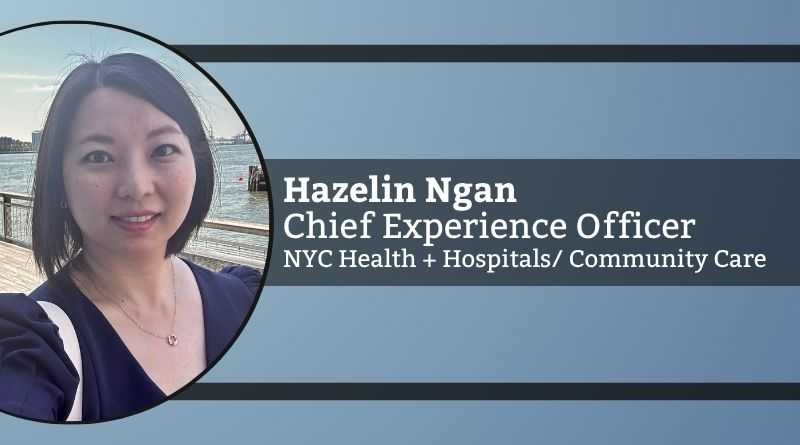More Human, Not Less: Rebuilding Connection in Healthcare Through Purposeful Technology
By Hazelin Ngan, MHA, MA, LSSBB, PMP, CPXP – Chief Experience Officer, NYC Health + Hospitals/ Community Care
Introduction
In healthcare, our most powerful resource isn’t technology, it’s people. And yet, in a field driven by compassion and connection, digital tools can sometimes pull us further apart. Teams are spread across states, boroughs, and service lines. Patients often feel like numbers. Even colleagues may drift into isolation as workloads increase and time for meaningful interaction shrinks.
As a Chief Experience Officer for America’s largest public healthcare system, I’ve seen how technology can both hinder and help the human experience. When used intentionally, it fosters trust, empathy, and community. It becomes a nuisance if it is poorly conceived or executed without context. Innovation should be driven by humanness rather than just speed or scale.
Fragmentation and Burnout: A Human Problem Needing Human-Centered Tech
Modern healthcare is complex. We navigate constant urgency, emotional labor, and fragmented systems. While digital tools promise efficiency, they can unintentionally amplify disconnection. A nurse may spend more time clicking checkboxes than speaking with patients. A care manager may rarely connect with colleagues beyond their specialty. A patient may feel lost in a maze of automated systems.
Burnout isn’t just physical fatigue, it’s emotional disconnection. Purpose fades when people feel unseen, unheard, and unsupported. Technology can either reinforce that perception, or help us rebuild relationships.
Tech That Connects, Not Distracts
Small, thoughtful applications of tech can go a long way. In our division, something as simple as a group chat has reconnected care teams across sites and brought people out of silos. Staff share questions, encouragement, humor, and gratitude, rebuilding camaraderie in real time.
Collaboration platforms help unite borough-based teams who otherwise almost never meet. Virtual meetings offer space for shared learning and storytelling. Even digital dashboards, when designed well, can alert managers to early signs of staff fatigue and the need for support.
The point isn’t complexity, it’s intentionality. Technology becomes meaningful when it meets real human needs and strengthens connection.
We don’t need tech that dazzles. We need tech that serves. Serves people. Serves purpose. Serves thoughtful care. Because in the end, it’s not about being more digital. It’s about being more human.
The Double-Edged Sword of Digital Efficiency
However, technology doesn’t always lighten the load. Sometimes it adds to it.
One of the most time-consuming parts of a provider’s day is documentation. We’ve all heard it said: “If it’s not documented, it didn’t happen.” But when systems are clunky or detached from workflow, they pull clinicians away from what matters most, patients and people. Moments of care become data points. Conversations become dropdown menus.
Innovation that prioritizes compliance over context risks dehumanizing the work. Digital forms, learning modules, or wellness platforms that are too complex or poorly timed will be ignored, regardless of intention. We cannot afford to let our tech tools desensitize care providers from what truly matters. Design determines usability and design must begin with empathy.
Patient Experience: The Human Side of Digital Convenience
Patient experience is directly impacted by good or bad technology. Done right, digital tools enhance access and ease. A nervous patient can message their provider instead of calling. A caregiver juggling multiple appointments can check schedules and labs in one place. Technology can reduce friction and anxiety.
But we’ve all experienced the opposite: filling out forms online, only to be handed the same ones on paper; checking in on the app, only to be told at the counter it didn’t register. These moments chip away at trust. They turn convenience into aggravation.
There’s no avoiding technology, it’s part of our care landscape. But we must repeatedly ask: Will this make life easier for patients and staff, or add to their pain points?
Bridging the Digital Divide
Another reality: we’re all navigating this digital world with varying levels of comfort. Some of us can type at 200 words per minute in the dark. Others struggle to download an app or navigate a portal. But that shouldn’t make anyone more or less capable of giving or accessing care.
We must design systems that bridge, not widen, the gap. Accessibility, digital literacy, and user-friendliness can’t be afterthoughts. What feels intuitive to one person may feel alienating to another. Tech should level the playing field not add more obstacles.
Don’t Forget the Human Touch
While virtual connections are helpful, they cannot replace face-to-face interaction. No dashboard or chat thread can replicate the trust built from sharing physical space.
As leaders, we must know when to pause the platforms and bring people together face-to-face to laugh, problem-solve, grieve, or reflect. That’s how culture is built and belonging formed. Technology should support not replace human contact.
Co-Creation, Not Top-Down Implementation
In healthcare, stakes are high. That’s why we must stop rolling out tech for people and start building it with them. The best digital solutions need not be flashy, but they must be co-created with frontline users.
When we launched a staff recognition campaign last year, we didn’t just dream it up behind closed doors. We asked staff how they wanted to be recognized, what mattered to them, and who they wanted to hear from. As a result, people used it because it felt real.
Whether it’s a communication app, scheduling tool, or patient feedback portal, the same rule applies: invite feedback and listen first, then design.
A More Human Future
Emerging technology holds real promise in healthcare (imagine the time we could save). However, we must resist the urge to treat it as a silver bullet. AI, automation, and data tools can help us scale but humanness is what helps us heal.
Our job isn’t just to adopt tools with the latest and greatest. It’s to ask the right questions:
- Will this make people feel more connected or more isolated?
- Will it ease or add to the workload?
- Is it built for real-life workflows?
- Does it strengthen trust—between staff, patients, and the organization?
We don’t need tech that dazzles. We need tech that serves. Serves people. Serves purpose. Serves thoughtful care.
Because in the end, it’s not about being more digital. It’s about being more human.

